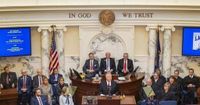Across the United States, state and local governments are grappling with the hard realities of tightening budgets, dwindling revenues, and evolving mandates. This week, a series of major announcements from Washington, Idaho, and North Carolina revealed the scope and complexity of the fiscal challenges facing public agencies as they head into 2026 and beyond. From county boards to state legislatures, leaders are weighing tough decisions that could reshape essential services for millions.
In Thurston County, Washington, the Board of Commissioners convened on Wednesday, September 17, 2025, to hear budget-cutting proposals from elected officials and department heads. The goal: to slash spending and lay the groundwork for a significantly reduced 2026 budget. According to a county news release cited by The Olympian, the urgency stems from a structural deficit that’s been years in the making. Since 2001, a state legislature-imposed cap on property tax increases—just 1% per year—has severely limited revenue growth. Thurston County’s general fund, which covers operating expenses, receives only about 8% of incoming property tax revenue. With inflation outpacing this growth, the county faces persistent shortfalls.
“Unlike federal or state agencies, Thurston County doesn’t make laws; it carries them out,” the county said in its release. That distinction matters, because state and federal mandates often arrive without the necessary dollars to implement them. Departments across the board are feeling the strain, with nearly 70% of the county’s general fund dedicated to law and justice services—leaving just 30% to support all other offices and departments. Many essential programs, from health and social services to corrections and public defense, were initially funded with state or federal money that has since dried up. Now, growing costs and expanding services are left to local funding, creating what officials describe as a substantial financial burden.
To address these challenges, Thurston County is taking a new approach. With leadership from its newly expanded board and executive team, officials are conducting a deeper analysis of spending patterns and long-term funding sources. Budget staff have been working throughout 2025 to provide the Board of County Commissioners with better, faster visibility—acting as an early warning system and enabling more agile adjustments. One recent move, the purchase of a downtown property using funds from a previous bond, won’t impact the general fund. The money must be spent by the end of October to avoid arbitrage, and officials believe the acquisition will make service delivery more efficient and accessible, remove lease burdens from the general fund, and provide long-term assets for the county.
The county’s approach is notably collaborative. Officials emphasize their commitment to an open process, with all public board meetings and work sessions listed in advance and available for viewing online. Budget presentations are shared throughout the year, and both written and verbal public comments are encouraged. As they brace for difficult decisions, commissioners say they’re looking to the future and working closely with the community to find solutions.
Meanwhile, Idaho’s state government is facing its own fiscal reckoning. On the same day as Thurston County’s budget summit, the Idaho Division of Financial Management issued a sweeping directive: all state agencies and departments—except public schools—must cut their fiscal year 2027 budget requests by 3%. As reported by the Idaho Capital Sun, this move makes permanent the 3% budget holdbacks that Governor Brad Little ordered for the current fiscal year 2026 back in August. But the cuts don’t stop there. Agencies must also eliminate all general fund requests for replacement items, such as new equipment or vehicles, for the upcoming year.
In a memo to agency directors and fiscal officers, Idaho Division of Financial Management Administrator Lori Wolff explained, “This effort is about ensuring that Idaho government remains lean, efficient, and aligned with the values of our taxpayers. By right-sizing government today, we strengthen our ability to fund the state’s highest priorities well into the future and create an even stronger economy.”
The roots of Idaho’s budget squeeze can be traced to the 2025 legislative session, when lawmakers and Governor Little reduced state revenue by over $450 million to pay for a series of tax cuts and a new education tax credit. Since then, state revenues have fallen short of projections. Through the first two months of fiscal year 2026, revenues were $22.6 million—2.8%—below the Division of Financial Management’s revised forecast. The state had planned to end the year with a $439.8 million surplus, but that projection has shrunk to just $21.8 million as revenues lag.
Senate Minority Leader Melissa Wintrow, D-Boise, didn’t mince words. “I wish I could say I was surprised, but it doesn’t make it any less infuriating,” she told the Idaho Capital Sun. Describing the situation as “gross negligence,” Wintrow argued that the Legislature and Governor Little cut revenue too deeply and spent more on tax cuts than the state could afford. House Minority Leader Ilana Rubel, D-Boise, warned that the state could actually be facing a $200 million deficit for fiscal year 2026, not a surplus, once supplemental Medicaid funding and the costs of conforming to new federal tax law changes are factored in.
The uncertainty isn’t lost on state officials, who acknowledge that with nearly 10 months left in the fiscal year, revenues could rebound—or fall further. Additional budget cuts remain a possibility if the numbers don’t improve.
In North Carolina, the story is different but no less complex. On Thursday, September 18, 2025, the N.C. School Superintendents’ Association released new figures showing a significant drop in teaching vacancies at the start of the 2025-26 school year: 2,155, down 31% from the previous year. Across the state’s 115 school districts, total vacancies fell 26% to 6,209. The declines were broad-based: elementary school teaching vacancies dropped 35%, middle schools 37%, high schools 34%, and special education 20%. Even bus driver and counselor positions saw decreases.
According to Jack Hoke, executive director of the School Superintendents’ Association, the drop is largely due to the end of federal COVID-19 funding that had allowed districts to hire extra staff. “With fewer overall positions in school districts, and staff that had previously held those support positions now filling positions where there may have otherwise been a vacancy, it makes sense that there would be fewer vacancies statewide,” Hoke explained to the Raleigh News & Observer.
But the numbers mask deeper challenges. Many districts, such as Winston-Salem/Forsyth County Schools, are laying off teachers and other employees due to budget deficits—$46 million in that district alone. State lawmakers are returning to Raleigh next week, but there’s no clear indication if or when new raises for teachers will be approved. North Carolina ranks 39th in the nation in beginning teacher pay and 43rd overall, according to the National Education Association. Adjusted for inflation, teachers are making 5% less on average than they did a decade ago. Hoke noted, “Despite the great work districts have been doing in this space, the fact of the matter is, education remains an under-compensated, under-resourced and underappreciated field.”
Whether it’s a county in Washington, a state in the Mountain West, or a school system in the Southeast, the message is clear: balancing budgets in the face of limited revenues, unfunded mandates, and rising costs is a challenge that will require creativity, collaboration, and, above all, tough choices.




